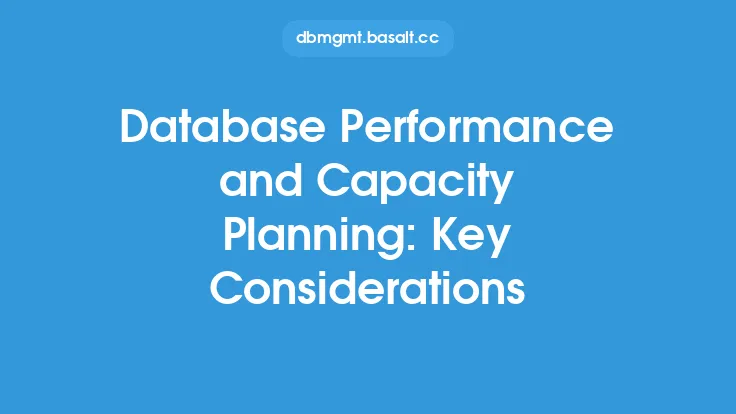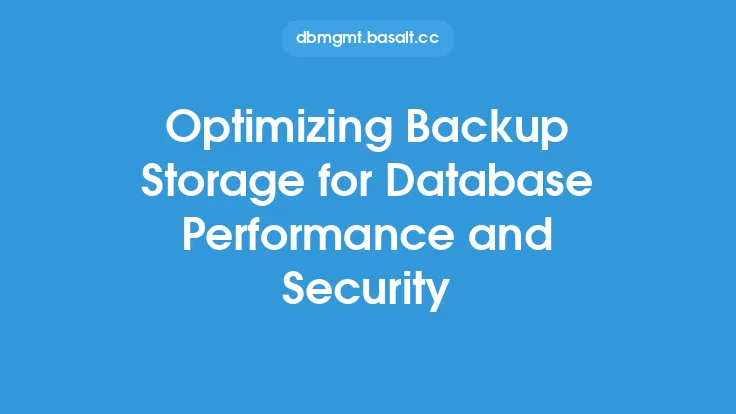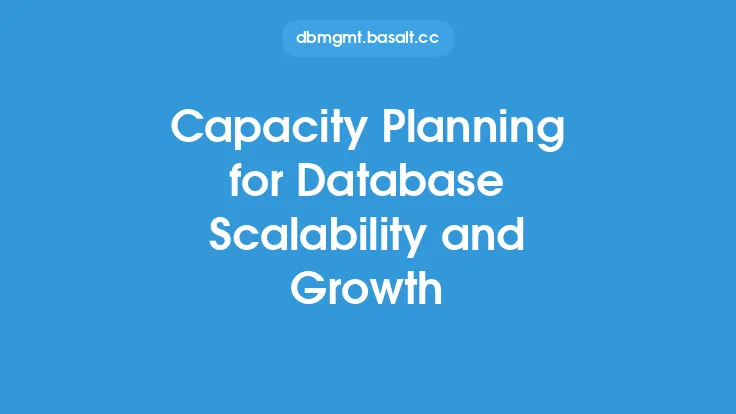When it comes to database capacity planning, one of the most critical aspects to consider is optimizing database resources. This involves ensuring that the database is utilizing its available resources in the most efficient manner possible, in order to support the required workload and performance levels. Optimizing database resources is essential for efficient capacity planning, as it enables organizations to make the most of their existing infrastructure, reduce costs, and improve overall database performance.
Introduction to Database Resource Optimization
Database resource optimization involves analyzing and tuning the database's configuration, indexing, and query execution plans to ensure that resources such as CPU, memory, and storage are being utilized efficiently. This process requires a deep understanding of the database's internal workings, as well as the specific requirements of the application or workload being supported. By optimizing database resources, organizations can improve query performance, reduce latency, and increase overall system throughput.
Understanding Database Resource Utilization
To optimize database resources, it's essential to understand how the database is utilizing its available resources. This involves monitoring and analyzing key performance metrics such as CPU utilization, memory usage, disk I/O, and network traffic. By analyzing these metrics, database administrators can identify bottlenecks and areas where resources are being underutilized or overutilized. For example, if the database is experiencing high CPU utilization, it may be necessary to optimize queries or indexing to reduce the load on the CPU. Similarly, if memory usage is high, it may be necessary to adjust the database's memory allocation or implement more efficient caching mechanisms.
Optimizing Database Configuration
One of the most critical aspects of database resource optimization is configuring the database for optimal performance. This involves setting key parameters such as buffer pool size, sort area size, and log buffer size. The buffer pool size, for example, determines the amount of memory allocated to the database for caching data, while the sort area size determines the amount of memory allocated for sorting operations. By adjusting these parameters, database administrators can optimize the database's performance and reduce the load on system resources.
Indexing and Query Optimization
Indexing and query optimization are also critical components of database resource optimization. Indexing involves creating data structures that enable the database to quickly locate and retrieve data, reducing the need for costly full-table scans. By creating efficient indexes, database administrators can improve query performance and reduce the load on system resources. Query optimization, on the other hand, involves analyzing and rewriting queries to ensure that they are executing efficiently. This may involve rewriting queries to use more efficient join methods, reducing the number of subqueries, or optimizing query execution plans.
Storage and Disk I/O Optimization
Storage and disk I/O optimization are also essential for efficient database resource utilization. This involves ensuring that the database's storage subsystem is properly configured and optimized for performance. This may involve using high-performance storage devices such as solid-state drives (SSDs), optimizing disk layouts and configurations, and implementing efficient disk I/O scheduling algorithms. By optimizing storage and disk I/O, database administrators can reduce latency and improve overall system throughput.
Network and Communication Optimization
Finally, network and communication optimization are critical for efficient database resource utilization. This involves ensuring that the database is properly configured for network communication, using protocols such as TCP/IP or InfiniBand. By optimizing network communication, database administrators can reduce latency and improve overall system throughput. This may involve implementing techniques such as connection pooling, statement caching, and result set caching to reduce the overhead of network communication.
Best Practices for Database Resource Optimization
To optimize database resources, database administrators should follow a number of best practices. These include:
- Monitoring and analyzing key performance metrics to identify bottlenecks and areas for optimization
- Configuring the database for optimal performance, including setting key parameters such as buffer pool size and sort area size
- Creating efficient indexes and optimizing queries to reduce the load on system resources
- Optimizing storage and disk I/O to reduce latency and improve overall system throughput
- Implementing efficient network communication protocols and techniques to reduce latency and improve overall system throughput
- Regularly reviewing and updating database configuration and optimization strategies to ensure that they remain effective and efficient.
Conclusion
Optimizing database resources is a critical aspect of efficient capacity planning, enabling organizations to make the most of their existing infrastructure, reduce costs, and improve overall database performance. By understanding database resource utilization, optimizing database configuration, indexing and query optimization, storage and disk I/O optimization, and network and communication optimization, database administrators can ensure that their databases are running at optimal levels. By following best practices and regularly reviewing and updating database configuration and optimization strategies, organizations can ensure that their databases remain efficient, effective, and scalable, even as workloads and performance requirements continue to evolve.





